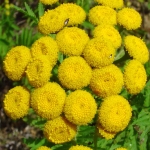| Common Name: |
Tansy |
| Botanical Name: |
Tanacetum vulgare syn. Chyrsanthemum vulgare |
| Genus: |
Tanacetum |
| Family: |
Asteraceae |
| Native Location: |
Europe |
| Cultivation: |
Well-drained to dry, stony soil in sun. Remove dead flower heads or Tanacetum parthenium to prevent excessive self-seeding. Tanacetum vulgare is invasive. |
| Propagation: |
By seed sown at 10-13°C (50-55°F) in spring (species and some variants only); by division in spring or autumn; by basal cuttings in spring; by semi-ripe cuttings in summer. |
| Harvest: |
Whole plants (T. parthenium, T. vulgare) are cut when flowers, and leaves are picked as required, and used fresh or dried in infusions, liquid extracts, powders, and tinctures. Tanacetum vulgare is distilled for oil. Leaves (T. parthenium) are sometimes eaten fresh, or dried for use in tablets to treat migraine, rheumatism, and arthritis. Flowers (T. cinerariifolium are picked as they open and are dried for powder. |
| Height: |
60cm-1.2m (2-4ft) |
| Width: |
Indefinite |
| Variants: |
Var. Crispum
(fern-leafed tansy)
Has finely cut leaves; less invasive than the species. |
Isla Gold
Has golden foliage that withstands full sun. Originated at West Acre Gardens, Norfolk, England. |
Silver Lace
Has white-variegated leaves. |
|
| Hardiness: |
Z4-9 |
| Parts Used: |
Whole plant, Oil |
| Chemical Constituents: |
Bitters
Borneol
Camphor
Resin
Tanacetin
Tanacetol
Thujone
|
| Properties: |
A bitter, acrid, warming herb with a pungent aroma. It expels intestinal parasites, benefits the digestion, and stimulates the uterus. |
| Known Effects: |
Stimulates uterine contractions
Stimulates appetite
Kills intestinal parasites
Miscellaneous Information:
Tansy is a powerful herb that should be avoided or used only under strict medical supervision.
|
| Possible Additional Effects: |
May treat pain
May cause euphoria
May treat roundworms and pinworms
May treat menstrual difficulties
|
| Medicinal Uses: |
Mainly used as an enema for expelling roundworms and threadworms in children, and topically in lotions for scabies, lice and fleas. |
| Warnings and Precautions: |
The herb is possibly unsafe for internal use, especially in pregnancy, although sometimes recommended for nausea and failure to menstruate.
Excess causes abortion, venous congestion of abdominal organs, and convulsions.
Tansy oil is highly toxic for both internal and external use, and very small amounts may prove fatal.
This herb, especially as tansy oil, is subject to legal restrictions in some countries.
Don't take if you:
Are pregnant, think you may be pregnant, or plan pregnancy in the near future
Have any chronic disease of the gastrointestinal trct, such as stomach or duodenal ulcers, reflux esophagitis, ulcerative colitis, spastic colitis, diverticulosis, or diverticulitis
Consult your doctor if you:
Take this herb for any medical problem that doesn't improve in 2 weeks (There may be safer, more effective treatments.)
Take any medicinal drugs or herbs including aspirin, laxatives, cold and cough remedies, antacids, vitamins, minerals, amino acids, supplements, other prescription or non-prescription drugs
Pregnancy:
Dangers outweigh any possible benefits. Don't use.
Breastfeeding:
Dangers outweigh any possible benefits. Don't use.
Infants and Children:
Treating infants and children under 2 with any herbal preparation is hazardous.
Others:
Dangers outweigh any possible benefits. Don't use.
Storage:
Store in cool, dry area away from direct light, but don't freeze.
Store safely out of reach of children.
Don't store in bathroom medicine cabinet. Heat and moisture may change the action of the herb.
Safe Dosage:
Consult your doctor for the appropriate dose for your condition.
|
| Toxicity: |
Rated dangerous, particularly in children, persons over 55 and those who take larger than appropriate quantities for extended periods of time. |
| Adverse Reactions, Side Effects or Overdose Symptoms: |
| Signs and Symptoms |
What to Do |
|
| Coma |
Seek emergency treatment |
| Convulsions |
Seek emergency treatment |
| Diarrhea |
Discontinue. Call doctor immediately. |
| Dilated Pupils |
Seek emergency treatment |
| Nausea or Vomiting |
Discontinue. Call doctor immediately |
| Weak, Rapid Pulse |
Seek emergency treatment |
|
| Culinary Uses: |
Leaves are used with discretion for flavoring; traditionally added to a kind of custard, known as a tansy, and to tansy cakes and puddings. |
| Bibliography: |
The Encyclopedia of Herbs by Deni Bown Copyright © 1995, 2001 Dorling Kindersley Limited. pp. 381-382
Vitamins, Herbs, Minerals & Supplements The Complete Guide by H. Winter Griffith, MD. Copyright©1998 Fisher Books pp. 449-450 |
